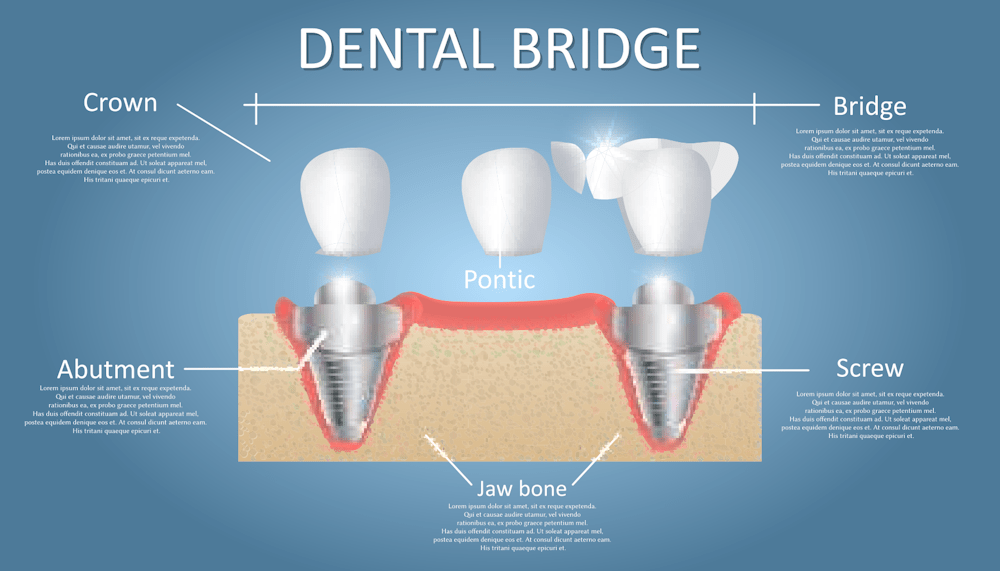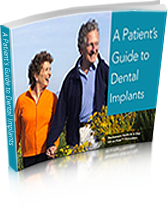
Key Takeaways
- Dental Implants: A permanent, durable solution for tooth replacement that looks and feels like natural teeth. Ideal for those seeking a long-term, stable option.
- Dental Bridges: A quicker and cost-effective alternative to implants for restoring gaps in your smile, especially suitable for those who don’t qualify for implants.
- Benefits at Our North York Clinic: Expert care, advanced technology, and personalized treatment plans to ensure the best possible results for your smile.
- Consultation is Key: Whether you're interested in implants or bridges, a consultation at our North York clinic will help determine the best treatment plan for your needs.
What are the main differences between dental bridges and implants?
Imagine you've lost a tooth — what next? Your dentist might recommend two popular restorative options: dental bridges and dental implants. At a glance, both restore function and aesthetics, but how they do it is significantly different.
Dental Bridges: Definition and Function
A dental bridge literally "bridges" the gap left by a missing tooth using the support of the adjacent natural teeth. Here's how it works:
- The teeth on either side of the gap are prepared and crowned.
- A false tooth (pontic) is placed in the gap, held by the crowns.
- The structure is cemented onto the natural teeth.
Bridges rely heavily on surrounding teeth, leading to wear over time. Still, they offer a fast, relatively non-invasive solution.

Dental Implants: Definition and Function
A dental implant is a titanium post surgically embedded into the jawbone, mimicking a tooth root. After it fuses with the bone through osseointegration, a crown is placed on top.
Key components of an implant system include:
- Implant fixture (post): Inserted into the jawbone
- Abutment: Connector between the implant and crown
- Crown: Custom-made to match your natural teeth
Implants function like natural teeth and don’t affect adjacent ones, preserving long-term oral health.

Procedure Steps Compared
| Step | Dental Bridge | Dental Implant |
| Evaluation | Dental exam, X-rays | Dental exam, X-rays, bone density check |
| Preparation | Adjacent teeth reshaped | Jawbone prep (bone graft if needed) |
| Surgery | No surgery needed | Minor surgical procedure |
| Healing Time | Immediate or a few days | Several months (osseointegration) |
| Final Placement | Cemented in 1–2 visits | Crown placed after healing (3–6 months) |
Materials Used
- Bridges: Porcelain fused to metal, ceramic, or zirconia
- Implants: Titanium post; porcelain, ceramic, or zirconia crown
Daily Function and Lifestyle Impact
- Implants: Feel and function like natural teeth. You can eat, speak, and floss normally.
- Bridges: May require special flossing tools. Put more strain on adjacent teeth.
In short, implants are more independent and mimic real teeth better, while bridges are quicker to place and may be preferred in specific medical or financial scenarios.
How do dental implants and bridges compare in terms of longevity?
One of the most important considerations when choosing between a bridge and an implant is how long each will last. Patients often ask: "Which will serve me best over the next 10, 20, or 30 years?"
Lifespan: A Tale of Two Restorations
- Dental Implants can last 25 years or longer with proper care. Some patients even retain them for life.
- On the other hand, dental Bridges typically last 10 to 15 years before needing replacement.
In the study Long-Term Outcomes of Dental Implants: A Review of the Literature (International Journal of Implant Dentistry), survival rates for implants were reported at over 90% after 10 years, significantly higher than those of bridges.
Maintenance Requirements
- Implants require regular brushing, flossing, and dental visits like natural teeth.
- Bridges require special flossing tools like threaders or water flossers to clean under the pontic.
Failing to maintain either option can lead to problems — peri-implantitis for implants or decay under crowns for bridges.
Replacement Cycles
| Feature | Dental Implant | Dental Bridge |
| Typical Lifespan | 25+ years | 10–15 years |
| Replacement Cost | Crown only, if needed | Entire bridge structure |
| Maintenance Complexity | Low | Moderate to high |
So, in terms of longevity and ease of care, implants usually win—but they require healthy bone and time to integrate.
Which option is more cost-effective: a tooth bridge or a dental implant?
Initial Treatment Costs
- Bridges typically have lower upfront costs because they involve no surgery.
- Implants require surgical placement, which increases initial costs.
Hidden and Long-Term Costs
Bridges:
- May require replacement every 10–15 years.
- Risk of decay or damage to adjacent teeth, increasing future dental bills.
Implants:
- Bone grafts may be required if bone volume is low.
- Longer healing process — but once placed, they rarely need replacement.
Summary Table: Cost-Effectiveness Considerations
| Factor | Dental Bridge | Dental Implant |
| Upfront Cost | Lower | Higher |
| Long-Term Cost | Higher (replacements) | Lower (durable) |
| Insurance Coverage | Often covered | Limited, varies |
| Additional Costs | Minimal | Bone grafts, longer process |
| Value Over Time | Moderate | High |
How long is the recovery time for bridges vs. implants?
Patients often ask how soon they'll be back to normal after getting a bridge or implant. The answer? It depends on the procedure and your healing response.
Recovery Timeline for Dental Bridges
- Day of procedure: Minimal discomfort
- Next few days: Some sensitivity or soreness
- 1 week: Adjusted to eating and speaking
There’s usually no downtime, and most patients return to normal activities the same day.
Recovery Timeline for Dental Implants
Because implants involve surgery, healing takes more time:
- First 2–3 days: Swelling, mild pain, dietary restrictions
- 1–2 weeks: Gum tissue begins to heal
- 3–6 months: Bone fuses with implant (osseointegration)
- Final crown placed after fusion
During this time, you may wear a temporary crown or flipper. The key is allowing the implant to integrate fully for a stable result.
Activity and Dietary Restrictions
| Activity | Bridge | Implant |
| Eating | Resume same day | Soft foods for 1–2 weeks |
| Work/School | Same day return | 1–3 days off depending on job |
| Physical Activity | Next day | Avoid for 72 hours |
Although implants require patience, the long-term benefit of a stronger, more durable tooth replacement is often worth the wait.

What are the pros and cons of each treatment for tooth replacement?
Choosing between implants and bridges isn’t just a clinical decision — it’s also about lifestyle, aesthetics, and personal goals. Here's a concise breakdown:
Dental Implants
Pros:
- Feels like a natural tooth
- Does not affect neighbouring teeth
- Long-lasting (25+ years)
- Easier to clean
- Prevents bone loss
Cons:
- Higher upfront cost
- Requires surgery
- Longer treatment timeline
Dental Bridges
Pros:
- Shorter treatment time
- Less expensive initially
- No surgery required
Cons:
- Alters adjacent healthy teeth
- Risk of decay under crowns
- May need replacement in 10–15 years
Who is a good candidate for dental implants or bridges?
Not everyone walks into a dentist’s office and walks out with a dental implant or bridge. The decision depends on many personal factors, including age, general health, bone structure, and habits like smoking.
Age and Health Status
You might think age is the most significant deciding factor, but actually, it's overall health that carries more weight. While dental implants are often recommended for adults whose jawbones have fully matured (usually after age 18–21), bridges may be a suitable option for younger patients or those who can’t undergo surgery.
Chronic conditions like diabetes, cardiovascular disease, or autoimmune disorders may complicate the implant procedure. These patients might be steered toward bridges instead, depending on how well their condition is managed.
Bone Density Requirements
Here’s where implants get a little more selective. You need sufficient bone density to insert a titanium implant into the jaw. If bone loss has already occurred — often due to a missing tooth — patients may first require bone grafting, which increases healing time and costs.
Bridges, by contrast, do not require strong bone support under the missing tooth. They simply rely on neighbouring teeth (abutments) for anchoring.
Dr. Amir Guorgui, BSC, DMD, MACSD, notes: “We assess bone density through 3D imaging to ensure implants have a stable foundation. If patients aren’t candidates, we can look into grafts or suggest a bridge as a less invasive option.”
The Impact of Smoking
If you smoke, here’s a harsh truth: dental implants might not be for you. Smoking compromises oral tissue healing and raises the risk of implant failure due to infection and reduced blood flow. Bridges are less susceptible to these issues, making them more suitable for smokers, though quitting is always the best path for oral health.
Summary: Candidate Checklist
- Ideal Implant Candidates:
- Healthy adults with fully developed jawbones
- Non-smokers
- Adequate bone density or willingness to undergo grafting
- Good oral hygiene habits
- Ideal Bridge Candidates:
- Younger patients
- Those with health conditions preventing surgery
- Smokers
- Patients wanting a quicker, less invasive solution
Do implants look more natural than bridges?
Regarding appearance, the human eye is often the final judge. Patients want replacements that blend in perfectly with the rest of their teeth — both in colour and shape. So, how do bridges and implants stack up?
Gum Line and Contour
Dental implants have a strong advantage here. Because they’re anchored into the jawbone, they support the gum tissue and maintain a more natural gum line. This helps avoid the sunken or recessed look that sometimes develops around bridges over time.
Bridges, while often very aesthetic at first, can show changes as gums recede or adjacent teeth shift. The result? A slightly unnatural appearance as the years go on, especially if the bridge doesn’t sit flush with the gums.
Colour Matching and Transparency
Modern prosthetics — whether bridges or implants — are made from high-quality porcelain or zirconia. These materials allow colour customization, translucency, and light reflection similar to natural enamel.
However, implants tend to win in long-term aesthetics. They don’t rely on neighbouring teeth for support, reducing the risk of discolouration from decay or fillings.
As Dr. Robert Eisen puts it: “We can fine-tune the implant crown to match not just the colour but also the translucency of natural teeth. With bridges, that match can change if nearby teeth need treatment later.”
Long-Term Look
Let’s fast-forward 5–10 years. Patients with implants generally enjoy a consistent look, assuming good oral care. On the other hand, bridges may require replacement or repair due to wear, decay of abutment teeth, or shifting in the mouth.
How do implants and bridges affect your oral health over time?
Cosmetics aside, these restorations' long-term oral health effects should weigh heavily in any treatment decision.
Bone Preservation
When a tooth is lost, the jawbone beneath it begins to shrink — a process called bone resorption. Dental implants are the only tooth replacement option to stop or slow this process. Why? Because they stimulate the bone, much like natural roots do.
Bridges don’t interact with the bone underneath the gap. As a result, bone loss can continue, which may lead to changes in facial structure over time.
Impact on Adjacent Teeth
Bridges rely on nearby teeth for support. These “abutment” teeth must be filed down to accommodate the bridge, sometimes removing healthy tooth enamel. Over time, the stress on these teeth can lead to fractures, decay, or root canal treatment.
Implants, by contrast, are independent structures. They don’t alter or rely on adjacent teeth, making them the more conservative option for preserving surrounding tooth health.
Gum Health and Hygiene
Both bridges and implants require diligent oral hygiene, but the cleaning routine differs:
- Bridges: Must floss underneath the pontic (the false tooth), which can be tricky without special tools.
- Implants: Can be brushed and flossed like natural teeth, although care around the gum line is critical to prevent peri-implantitis (a gum infection around implants).
Patients who don’t maintain proper oral hygiene may face gum disease regardless of the option chosen, but implants tend to be more hygienic-friendly in daily routines.
Final Word on Oral Health Impact
- Implants:
- Preserve bone
- Protect adjacent teeth
- Easy to clean with good technique
- Bridges:
- May contribute to bone loss
- Can weaken adjacent teeth
- Require more intricate cleaning
What should you ask your dentist before choosing a tooth replacement?
Walking into a dental consultation without preparation can leave you feeling overwhelmed. Whether leaning toward an implant or a bridge, arming yourself with the right questions can make a difference.
Pre-Consultation Checklist
Before even sitting in the chair, jot down some key aspects you want to address:
- Your medical history: Any past surgeries, chronic illnesses, or medications.
- Lifestyle habits: Smoking, alcohol use, or conditions that may impact healing.
- Budget and insurance: What’s covered? What isn’t?
Essential Questions to Ask
Here are some of the most important questions patients should raise during the consultation:
- What are the pros and cons of bridges vs. implants in my case?
- Do I have enough bone density for an implant?
- Will I need additional procedures like bone grafting?
- What materials will be used in my crown or bridge?
- How long will the recovery take?
- What are the possible complications?
- How long can I expect this treatment to last?
- What are the daily care requirements?
- Is one option more likely to require future adjustments?
- How many of these procedures have you performed?
Materials and Outcomes
Discuss what kind of materials will be used in the prosthetics:
- Zirconia vs. Porcelain: Strength and appearance.
- Titanium Implants: Durability and biocompatibility.
- Bridge Composition: Metal-ceramic blends or all-ceramic?

How should you decide between a bridge and an implant?
When deciding between a dental bridge and an implant, the answer comes down to your specific medical, financial, and aesthetic needs.
Summary Comparison Table
| Feature | Dental Implant | Dental Bridge |
| Procedure Type | Surgical | Non-surgical |
| Lifespan | 20+ years | 5–15 years |
| Bone Preservation | Yes | No |
| Impact on Other Teeth | None | Requires filing adjacent teeth |
| Aesthetic Outcome | More natural gum line | May degrade over time |
| Hygiene Maintenance | Brush/floss like natural teeth | Requires special floss tools |
| Insurance Coverage | Variable | Often better coverage |
| Upfront Cost | Higher | Lower |
Who Should Choose What?
- Choose a Dental Implant if you…
- Want a long-lasting solution
- Have good bone density or are open to grafting
- Prefer a natural appearance
- Are willing to undergo surgery
- Choose a Dental Bridge if you…
- Prefer a non-surgical option
- Have compromised health or are a smoker
- Need a faster fix
- Want a more cost-effective upfront option.
Experience the Best Tooth Replacement Solutions in North York
Our North York clinic proudly offers dental implants and bridges using the latest technology and a personalized approach tailored to your unique smile. Whether you're looking for the long-term benefits of implants or the efficient restoration of a bridge, our experienced team is here to help you regain confidence and function with expert care. Book your consultation today and discover why so many in North York trust us for tooth replacement needs.


